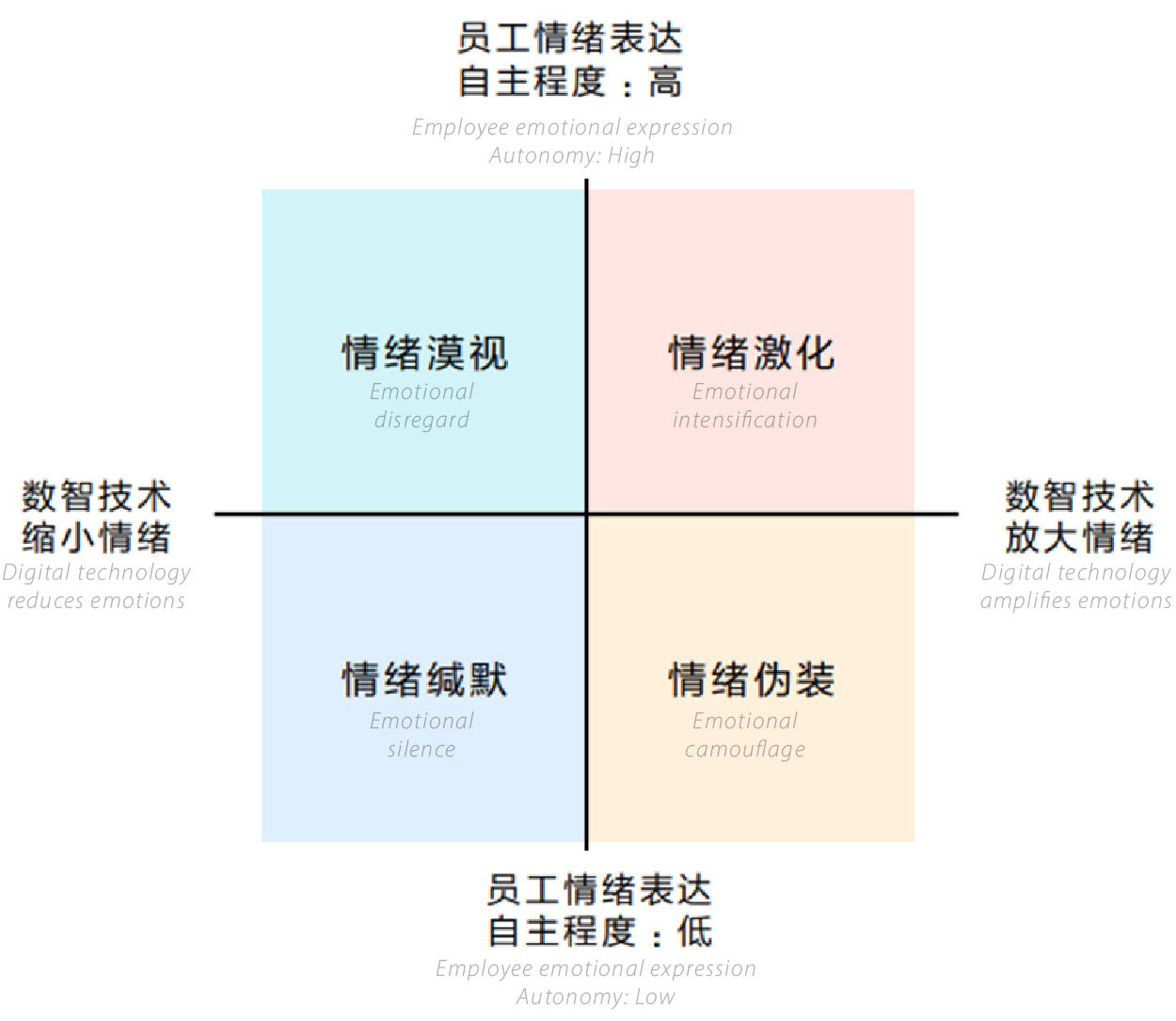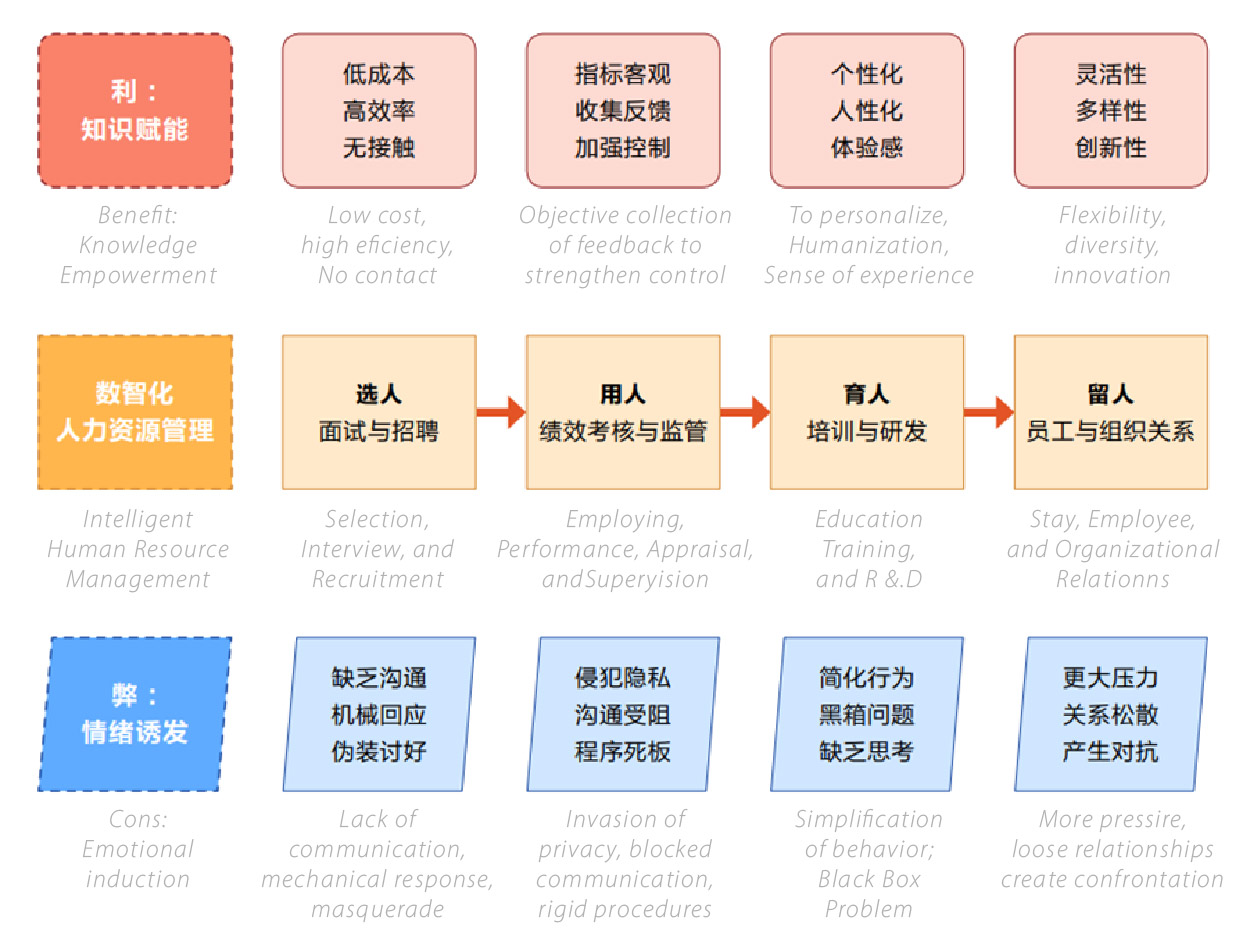
In the age of digital intelligence, more and more companies are beginning to apply digital intelligence technologies such as big data, algorithms, artificial intelligence and robots to the selection, recruitment, and training of human resource management in order to optimize management processes and the efficiency of decision-making, and retain employees and other key connections.
For example, companies such as L’Oréal, Uniqlo, Budweiser and Walmart have incorporated AI interviews into their hiring plans; Amazon has developed an AI efficiency monitoring and scoring system to monitor employees’ working conditions in real time and flag employees who take too long to pick up goods as "less efficient" tags, etc.
The use of digital intelligence technology has greatly reduced repetitive mechanical work in human resource management, thereby cutting labor costs. Alongside the benefits, however, there is also a major management risk - the "emotional volcano" among employees that could be about to erupt.
Professor MO Shenjiang from the School of Management at Zhejiang University, together with his doctoral students:
- SU Yi (Business Management Doctoral Candidates Class of 2022 in the School of Management)
- YU Wenqing (2021 Business Management Doctoral Candidates of the School of Management)
- and researcher FANG Yanran (Researcher, Department of Leadership and Organizational Management, School of Management),
found in their study that digital intelligence technology may cause some negative emotions among employees in the process of improving human resource management practices. These individual negative emotions will eventually accumulate into group-related emotional problems within the organization and pose a threat to the management and development of the organization.
|
MO Shenjiang | 莫申江 School of Management, Zhejiang University |
||
|
|
||
|
|
|
Academic Background: Prof. MO Shenjiang is an Associate professor at the School of Management of Zhejiang University. He specializes in research areas such as organizational behavior, leadership, corporate social responsibility, etc. He is a member of the editorial board of the Journal of Organizational Behavior and the editorial board of the Australian Journal of Management. He has published over 30 articles in international and Chinese journals, including Organizational Behavior and Human Decision Processes, Journal of Business Ethics, Applied Psychology: An International Review, Journal of Management and Organization, Management World (in Chinese), Acta Psychologica Sinica (in Chinese), etc. You can learn more about Prof. MO Shenjiang’s academic background here |
In recent years, based on the principle of integrated coordination of education, science and technology, the School of Management of Zhejiang College has organized and promoted the interdisciplinary construction of "digital intelligence, innovation and management", and carried out digital intelligence in decision-making, digital innovation, intelligent organization, intelligent finance, digital medical care, multi-directional research on intelligent services and other areas to serve national strategies. This research work of Professor MO Shenjiang’s team is one of the phased results of the construction of this discipline.
MO Shenjiang’s team focused on "emotional management" and researched group-related emotional problems that often occur in the process of digital intelligence management.
|
They found that digital intelligence-induced management can cause four types of "employee emotional problems" |
As an emerging management model for the future, digital intelligence management gives vitality to enterprises to reduce costs and increase efficiency, and promotes economic and social innovation and change.
However, if you focus too much on the data and facts that "do not deceive people" when implementing it, one is likely to overlook the large and small emotional "volcanoes" that are constantly generated and deposited by individuals in the company under the influence of the technological wave.
So, what do these emotional "volcanoes" look like? What emotional problems can employees have under the management of digital intelligence?
In the study, MO Shenjiang’s team analyzed the group-related emotional problems that often occur in digital intelligence management along two dimensions: Emotion generation (digital intelligence technology increases or decreases employees’ emotions) and emotional expression (employees have high or low autonomy in emotional expression). A classification and explanation were made as shown in Figure 2.

|
Figure 2 Typical Emotional Problems in Digital Intelligence Management |
|
In their research, MO Shenjiang’s team found that digital intelligence management may induce four typical "employee emotional problems", namely emotional indifference, emotional disguise, emotional intensification, and emotional reticence.

|
Image source: 千库网 |
|
EI |
Emotional Indifference | Employees feel lonely due to unfulfilled emotional expectations The technology of digital intelligence itself is "cold" and emotionless. When employees want to interact and build emotional connections, it is often difficult to achieve this with digital intelligence technology. Because it cannot provide employees with the emotional empathy and empathy that real leaders have, it can only provide preset, mechanical and so-called optimal responses based on data and algorithms. Since intelligent technologies cannot understand employees’ actions in response to real-life situations, they can often misjudge employee’ motivations and behaviors. If employees have no channels and opportunities for upward communication for a long time, their negative emotions will gradually build up and develop into a sense of alienation from the company or even hostile behavior. At the same time, the purpose of digital intelligence management is often taken to extremes to pursue only the best and fastest, which weakens respect for employees and eventually makes them "cold". This phenomenon is particularly pronounced in the platform economy. Takeaway drivers, for example, constantly flout traffic rules and even disdain the lives of passers-by in order to receive instant rewards from the system for every delivery charge and avoid negative customer reviews. |
|
ED |
Emotional Disguise | Employees hide their true selves in favor of digital intelligence tools In the context of digital intelligence management, some employees need to find ways to "please" digital intelligence tools in order to perform well. This behavior will reinforce employees internal sense of unreality among employees and cause them to change the purpose of their actions to meet the expectations of the system. This then leads employees to undertake an ‘emotional disguise’ to hide their true personality or values. This additional emotional labor can cause stress and anxiety for employees. In the long run, as engaging digital intelligence technologies become an important part of work, employees’ intrinsic motivation to work will gradually diminish and they will question the value and meaning of their work. |
|
ET |
Emotional Transformation | Amplification of employees’ negative emotions can lead to “black swan” effects Digital intelligence technology can inadvertently amplify the negative emotions of some employees, leading to emotional "black swans". This kind of "emotional aggravation" will drastically increase the job insecurity of every member of the organization and put the organization in a dangerous situation of "emotional opposition". On the one hand, digital intelligence technology may replace human jobs and lead to mass unemployment, causing employees to feel job insecurity. These negative emotions are gradually intensified and spread with the continuous development and spread of digital intelligence technology, causing internal problems within the organization. The entire workforce is in a negative mood. On the other hand, the improper use of digital intelligence technology can cause employees to rebel, and these emotions are further fermented and amplified with the help of the internet. This upgrades personal emotions to group emotions, intensifying the emotional opposition and disconnect between employees and the organization, which inevitably impacts both the employees and the organization. |
|
ER |
Emotional Reticence | Employees become silent due to fear of adverse consequences Since digital intelligence technology still cannot fully understand employees’ emotional expressions, and employees are afraid of the negative consequences of using digital intelligence technology for themselves, digital intelligence management will also lead to the problem of employee’ emotional mutism, which means that the emotions that were originally expressed to real people are now difficult to express. On the one hand, digital intelligence technology blocks the channels for normal emotional communication between employees and managers. If digital intelligence technology misjudges employee behavior and no real person responds to an employee’s complaint, it becomes difficult for employees to express and resolve their negative emotions. Over time, employees will choose to remain silent and stop expressing their emotions to their managers. On the other hand, employees may be more reluctant to use digital intelligence for fear of getting into trouble. For example, the use of digital monitoring technology makes every movement of employees transparent, and the monitoring data becomes the basis for performance evaluation and personal accountability. As a result, employees become more cautious in their words and actions in the workplace and are reluctant to make constructive suggestions for the company. Their reticence will also make it difficult for them to build deep emotional relationships with colleagues and managers. |
|
Tips on Emotional Management |
Research in the field of management psychology shows that employees’ inner negative emotions not only seriously affect their own work experience, but also significantly impact the long-term performance of the organization. Therefore, good management of employees’ emotions will, to a certain extent, determine the success or failure of "organizational digital intelligence" transformation.
From the above analysis, in the era of digital intelligence management, the occurrence of various emotional problems in organizations depends on many factors, such as people (including employees and leaders), digital intelligence technology, and management systems, all of which affect the occurrence of individual employees’ emotions. and the degree of emotional expression.
So how can we manage employees’ emotions? In this context, MO Shenjiang’s team proposed a series of response strategies to optimize emotion management, focusing on three aspects: People, Technology and Systems, as shown in Figure 3.

|
Figure 3 Strategies of Emotion Management in Digital Intelligence |
|
TIP 1 |
Cultivate the emotional capabilities of employees and leaders In the course of interacting with digital intelligence technology, employees and managers should continue to practice and improve their skills in dealing with emotions. Employees must reflect on their own uniqueness and importance as human beings in comparison to technology. The most important point is emotional-social intelligence. Bar-on, an American clinical and organizational psychologist, pointed out that the emotional-social intelligence (ESI) model includes five aspects: the ability to recognize, understand and express emotions and feelings, the ability to understand other people’s feelings and get along with others. the ability to manage and control emotions, the ability to cope with change, adapt and solve problems of a personal and interpersonal nature, the ability to generate positive emotions and self-motivation. The MO Shenjiang team believes that employees need to improve their ability to perceive and understand their own emotions, manage and control their own emotions, generate positive emotions and reduce negative emotions. Specifically, when faced with emotional problems, employees must firstly understand their own emotions, including the situations, causes, processes and typical reactions in which the emotions arise; secondly, they must rehearse alternative constructive responses in their minds to help themselves next time. Secondly, strengthening individual mindfulness as an important step to improve emotional-social intelligence also has a positive effect on solving employees’ emotional problems in managing digital intelligence. Mindfulness refers to a psychological training process in which individuals focus their attention on the present moment without judgment, gaining a deep understanding of themselves and becoming fully aware of their surroundings. Mindfulness can help employees to observe themselves objectively and soberly and to understand what is happening in the moment. At the same time, it requires employees not to make immediate judgments about the current phenomenon. This reduces the negative effects of immediate emotions and helps them to better understand and control their own emotions. As a role that has an important impact on employees’ emotions at work, leaders should reasonably solve the emotional problems that arise in digital intelligence management by exercising and improving digital intelligence leadership. Given the multiple tensions and conflicts that exist between employees and digital intelligence technologies, leaders need to motivate, support and encourage employees to adapt to digital intelligence work while improving their own emotional-social intelligence and increasing their empathy and empathy. use your own emotional influence to infect and help the employees around you, and truly realize humanistic care. In particular, leaders need to improve their empathy, recognize employees’ emotions accurately and timely, help employees solve emotional problems, and avoid the impact of pent-up negative emotions on employees’ personal performance and the overall efficiency of the organization; at the same time, leaders also need to use mindfulness, be aware of their own emotions and regulate them through other methods, show empathy on the basis of continuously maintaining their own emotional level, and better help employees around them to form a positive cycle. |

|
Image source: 千库网 |
|
TIP 2 |
Improve technical functions and design levels First, digital intelligence technology should continue to improve its practicality and its ability to perform basic tasks and human-machine collaboration to truly empower management and professionally support employees, rather than increasing employees’ workload and triggering negative emotions among employees. To this end, before adopting digital intelligence technologies, companies need to conduct thorough front-line research, comprehensively consider the company’s macro strategy, specific business problems and digital intelligence application scenarios, and develop targeted digital intelligence management solutions. In addition, researchers should further updateiterative digital intelligence technologies, make continuous breakthroughs in algorithms, basic computing power and data, promote the ability of tool systems to solve universal problems, and further support the implementation of technology applications. Second, the form of digital intelligence technology should be easier for employees to understand and reduce the cost of use. Digital intelligence technology should be designed so that even non-professional employees with basic digital knowledge can roughly understand the rules and processes of technical operation, reduce the opacity and uncertainty that employees perceive when interacting with digital intelligence technology, and improve their sense of confidence. In addition, digital intelligence technology should consider the different needs of potential users when designing, always adopt a human-centered approach, and reduce the negative emotions caused by inappropriate design among employees. Third, digital intelligence technology should better “understand” and help employees. Although digital intelligence technology is not yet able to understand human emotions, people can ensure that digital intelligence technology is able to identify employees’ emotional patterns through pre-design and provide personalized positive feedback and timely help to employees. Based on the successful identification of employees’ emotions, digital intelligence management should help employees to regulate their emotions in a targeted manner. |
|
TIP 3 |
Improve institutional guarantees for responding to emotional distress Improving human emotion management capabilities and the functions and design of intelligent technologies can effectively solve the problem of mutual incomprehension between humans and machines, and alleviate the emotional indifference and emotional labor of humans and machines. Facing the problems of emotional intensification and emotional silence, reasonable system design and implementation are even more important. Facing the problem of emotional intensification, organizations should build an emotional emergency management mechanism for their employees. Based on relevant research on social psychological crisis intervention, this emergency management mechanism should include an emotional early warning mechanism, a risk analysis and assessment mechanism, an emotional leadership mechanism, an emergency response mechanism, and a public opinion response mechanism. Organizations need to identify which employees are at emotional risk for specific employees and determine whether they should receive emotional crisis intervention. Provide timely emotional counseling to employees who are at high emotional risk and who will have a negative impact on other employees in the organization, and use the Employee Psychological Assistance Program (EAP) to provide social support and academic counseling to employees through multiple channels. In the event of sudden large-scale emotional events, organizations need to make contingency plans in advance and coordinate various departments and agencies inside and outside the organization to take emotional emergency measures. At the same time, given the importance of public opinion, organizations also need to build a mechanism to respond to emotional events in advance and strengthen public opinion monitoring and response with a realistic attitude. Facing the problem of emotional mutism, organizations should open up multiple communication channels for employees to express their true feelings and interests. Since the current digital intelligence technology does not have general intelligence, it cannot take into account the specifics of each employee, job and task, which can easily lead to rigid management. At this point, a system is needed to ensure that employees have the opportunity to object and explain, and that humans, not machines, make the final decision. A sensible system can ensure the flexibility and human warmth of digital intelligence management, create an outlet for employees to vent their emotions, and better maintain fairness and sustainability in the workplace. |

|
Image source: 千库网 |
|
The basis for building a sustainable organization for digital intelligence |
At present, the world has fully entered the era of digital intelligence, and various digital intelligence technologies are being integrated into the overall process of economic and social development at an accelerating pace. Only when enterprises make full use of digital intelligence technology and initiate digital intelligence management reforms can they take the lead in the digital intelligence era and enhance their competitiveness.
However, in this process, the emotional management of employees, a key issue that determines the success or failure of digital transformation in organizations, is often easily overlooked by managers.
This study by MO Shenjiang’s team focuses on several typical emotional issues that may occur among employees in the context of digital intelligence management and proposes "emotional management tips" for employees in the age of digital intelligence and discusses the aspects of digitally intelligent human resource management. The pros and cons offer a new perspective for organizational management research and provide companies with important ideas for building better and sustainable organizations with digital intelligence.

- We thank MO Shenjiang and his team for combining cutting-edge theories and analysis to support companies in their digital transformation.
- You can read the original article in Chinese here